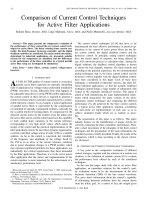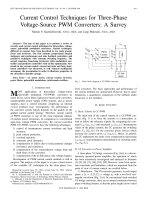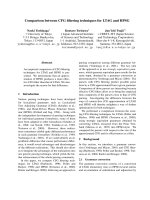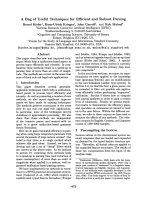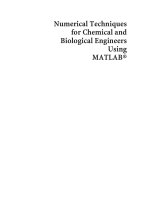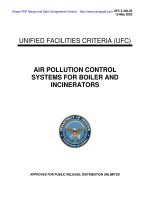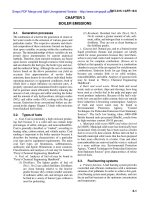Harmonic control techniques for inverters and adaptive active power (TQL)
Bạn đang xem bản rút gọn của tài liệu. Xem và tải ngay bản đầy đủ của tài liệu tại đây (6.54 MB, 179 trang )
University of Wollongong
Research Online
University of Wollongong Thesis Collection
University of Wollongong Thesis Collections
1998
Harmonic control techniques for inverters and
adaptive active power filters
Ali Hazdian Varjani
University of Wollongong
Recommended Citation
Varjani, Ali Hazdian, Harmonic control techniques for inverters and adaptive active power filters, Doctor of Philosophy thesis, School
of Electrical, Computer and Telecommunications Engineering, University of Wollongong, 1998. />
Research Online is the open access institutional repository for the
University of Wollongong. For further information contact Manager
Repository Services:
Harmonic Control Techniques for Inverters
and Adaptive Active Power Filters
A thesis submitted in fulfilment of the
requirements for the award of the degree of
DOCTOR OF PHILOSOPHY
from
UNIVERSITY O F W O L L O N G O N G
By
AH Yazdian Varjani, B.Sc, M.Eng (Hons.)
School of Electrical, Computer and
Telecommunication Engineering
November, 1998
In the name of God, the merciful and compassionate
Dedicated to my wife
who was beside me during these hard years
and my mother
who first encouraged me to undertake postgraduate stud
in
DECLARATION
This is to certify that the work presented in this thesis w a s performed by m e , unless
specified otherwise, and no part of it has been submitted previously for any other degree
to any other university or similar institution.
Ali Yazdian Varjani
IV
ACKNOWLEDGMENTS
I would like to express m y gratitude to m y supervisors Professor Joe Chicharo and
Dr Sarath Perera for their invaluable guidance and support throughout this research
work.
I wish also to thank the Ministry of Culture and Higher Education of Islamic Republi
Iran ( M C H E ) for awarding m e a research scholarship through which complete financial
support was provided.
The support of the Electricity Supply Association of Australia (ES AA) for funding t
project highly acknowledged. I would like to thank m y friends D r M . Tavasoli, D r A.
Shahri, D r A. Dastfan, D r A. Jalilian, and D r M . Kahani, for valuable tips, comments and
discussions. I also thanks D r Philip Oganbana for his comments and discussions and
M s B. Evans for her proofreading.
At last but not least, my deepest gratitude to my wife Monirossadat for her warm
supports, understanding and patiently taking upon on herself m y share of the
responsibilities at home.
Ali Yazdian Varjani
V
ABSTRACT
This thesis is concerned with the general issue of power quality. The specific areas of
interest include harmonic distortion and its minimisation. In particular the thesis
considers a P W M switching strategy which yields near optimal performance in terms of
harmonic distortion as well as on-line harmonic detection mechanisms and adaptive
active powerfilteringsolutions.
For the purpose of load side harmonic reduction, a novel equal area based PWM
( E A P W M ) switching strategy is developed which is suitable for voltage source full
bridge inverter applications. The objective of this strategy is to minimise both the
harmonic distortion and the switching losses in the inverter. Switching losses in the
inverter are minimised by developing a hybrid switching sequence. The harmonic
distortion is minimised by adopting a technique which ensures that the P W M pulses are
placed at appropriate positions of choice based on an equal area criterion so that their
areas are better matched with the areas under the reference waveform.
The EAPWM technique is evaluated and its performance is compared with existing
PWM
techniques including natural and regular P W M
switching strategies. The
performance evaluation and comparison is based on the total harmonic distortion and
m a x i m u m inverter fundamental output voltage. For a case where the ideal output
waveform is sinusoidal it is shown through simulation that the proposed technique
provides a P W M output with minimum harmonic distortion and m a x i m u m fundamental
voltage.
The second issue addressed by the thesis is adaptive active power filtering. The objec
is to develop an economical solution where a partial and flexible harmonic reduction
technique is provided such that the established harmonic standards are satisfied. Partial
and
selective compensation
of those individual harmonics which
exceed
the
VI
recommended levels as set by regulatory bodies reduces the rating of active power filters
thus leading to cost savings. This approach contrasts with existing techniques where the
objective is to reduce all possible harmonic components to zero.
A new control strategy for active power filters that combines adaptive online harmonic
estimation with partial and selective harmonic compensation schemes has been
implemented within an integrated controller. T o have an accurate online estimation of
harmonic components, a n e w adaptive structure based on a combination of resonator
filter bank and frequency demodulation frequency tracking is proposed.
Performance evaluation of the proposed technique for harmonic estimation for
time-varying nonlinear load is carried out where the simulation results show that the
proposed filter bank structure provides better performance w h e n compared to widely
used conventional technique such as short term Fourier transform. The proposed control
strategy has been implemented using a digital signal processor. Experimental results from
a laboratory prototype are presented showing steady state and transient performance. It
is shown that the proposed harmonic estimation together with the flexible harmonic
compensation scheme provides an efficient solution in reducing the power rating of the
active powerfilterwhile limiting specific harmonics to desired levels of compensation.
VII
AUTHOR'S PUBLICATIONS
A. Yazdian-Varjani, B. S. P. Perera, and J. F. Chicharo, " A Centroid-Based
P W M Switching Technique For Full-Bridge Inverter Applications," IEEE
Transactions on Power Electronics, vol. 13, pp. 115-124, 1998.
A. Yazdian-Varjani, J. F. Chicharo, and B. S. P. Perera, "An Introductio
Wavelets in Power Quality Analysis," Australasian Universities Power<
Engineering Conference, AUPEC'97, Sydney, pp. 277-281, 1997.
A. Yazdian-Varjani, B. S. P. Perera, J. F. Chicharo , and M. T. Kilani,
Equal Area Based Pulsewidth and Position Switching Strategy for FullBridge Inverter Applications," Australasian Universities Power Engineering
Conference, AUPEC96,
Melbourne, pp. 143-149, 1996.
A. Yazdian-Varjani, B. S. P. Perera, J. F. Chicharo , and M. T. Kilani,
"Sliding Measurement
of Power
System
Harmonics," Australasian
Universities Power Engineering Conference, AUPEC'96,
Melbourne, pp.
293-299, 1996.
A. Yazdian-Varjani, J. F. Chicharo, and B. S. P. Perera, "Adaptive Activ
Power Filtering" Submitted for review to IEEE Transactions on Power
Electronics, 1999.
VIII
CONTENTS
Chapter 1:
Preliminary
1
1.1 Introduction 1
1.2 Power System Harmonics
1
1.2.1 Harmonic Sources
2
1.2.2 Effects of Harmonic
1.2.3 Measurement of Harmonics
1.2.3.1 MEASUREMENT TECHNIQUES
1.2.4 Standards on Harmonics
1.2.4.1 AUSTRALIAN S T A N D A R D S O N H A R M O N I C S
1.3 Compensation of Harmonics
3
3
3
4
4
1.3.1 Harmonic Reduction Techniques
4
1.3.2 Passive Power Filters
5
1.3.3 Active Power Filters (APF)
6
1.3.3.1 PRINCIPLE OF ACTIVE P O W E R FILTER
1.3.4 Power System Connection
6
7
1.3.4.1 S H U N T CONFIGURATIONS
7
1.3.4.2 SERIES CONFIGURATIONS
8
1.3.4.3 H Y B R I D CONFIGURATIONS
8
1.3.5 Control Strategies
9
1.3.5.1 TIME D O M A I N A P P R O A C H E S
9
1.3.5.2 PREDETERMINED H A R M O N I C CANCELLATION
10
1.3.5.3 F R E Q U E N C Y D O M A I N A P P R O A C H E S
IX
2
10
1.4 Thesis Objectives and Outline
1.4.1 Pulsewidth Modulation ( P W M )
11
11
1.4.2 Adaptive Active Power Filter (AAPF)
11
1.4.2.1 H A R M O N I C ESTIMATION
12
1.4.2.2 P H A S E A N D F R E Q U E N C Y TRACKING
12
1.4.2.3 SELECTIVE A N D PARTIAL H A R M O N I C COMPENSATION SCHEMES. 12
1.4.3 Contributions of the Thesis
1.4.3.1 N E W P W M SWITCHING S T R A T E G Y
13
13
1.4.3.2 H A R M O N I C ESTIMATION
13
1.4.3.3 ADAPTIVE ACTIVE P O W E R FILTER
14
1.4.4 Thesis Outline
Chapter 2: Equal Area Based P W M Technique
14
15
2.1 Introduction 15
2.2 Conventional P W M Techniques
16
2.2.1 Natural Sampling P W M Technique
16
2.2.2 Regular Sampling P W M Technique
18
2.2.3 Equal Sampling P W M Technique (EST)
19
2.2.4 Centroid Based P W M Technique (CBT)
20
2.3 Equal Area Based P W M Technique ( E A P W M )
22
2.3.1 C B T and E A P W M Comparison
24
2.4 Simulation and Performance Analysis
26
2.4.1 Performance Evaluation
26
2.4.2 Simulation Results
27
2.4.3 Comparison of C B T with Sinusoidal P W M Techniques
30
2.4.4 Comparison of C B T and E A P W M
35
2.4.5 Predetermined Harmonic Cancellation
39
X
2.5
Switching Sequence
43
2.6
Conclusions
44
Chapter 3:
H a r m o n i c Estimation
45
3.1 Introduction 45
3.2
3.3
3.4
Harmonic Estimation
46
3.2.1 Fourier Transform
47
3.2.2 Short TermFourier Transform
48
Filter B a n k Based Harmonic Measurement
49
3.3.1 Filter bank Structure
50
3.3.2 Sliding Algorithm
54
Frequency Estimation
55
3.4.1 Adaptive IIR Filtering
55
3.4.1.1 G R A D I E N T D E C E N T A L G O R I T H M S
3.5
3.4.2 Frequency Demodulation Technique
58
3.4.2.1 Low P A S S FILTERING
60
3.4.2.2 DECIMATION
61
Simulation Results
61
3.5.1 Frequency Estimation
61
3.5.1.1 ADAPTIVE IIR FILTER
62
3.5.1.2 F M D E M O D U L A T I O N (FMD)
63
3.5.2 Harmonic Estimation
3.6
57
65
3.5.2.1 S H O R T T E R M FOURIER T R A N S F O R M
66
3.5.2.2 FILTER B A N K H A R M O N I C ESTIMATION A N D M E A S U R E M E N T
68
3.5.2.3 C O M P U T A T I O N A L B U R D E N
71
Conclusion
...71
XI
Chapter 4:
Active Power Filter Implementation
73
4.1 Introduction 73
4.2
Control Strategy
75
4.2.1 Data Acquisition
75
4.2.2 Frequency Tracking
76
4.2.2.1 FIR FILTERING
77
4.2.3 Harmonic Estimation and Prediction
78
4.2.3.1 H A R M O N I C ESTIMATION
4.2.3.2
78
78
H A R M O N I C PREDICTION
4.2.3.3 IIR FILTER B A N K
79
4.2.4 Active Power Filter Reference Waveform
4.2.4.1 P O W E R
4.2.4.2 DC
80
80
CALCULATION
81
LINK V O L T A G E CONTROLLER
4.2.5 Harmonic Compensation Schemes
4.2.5.1 FULL COMPENSATION
4.2.5.3 COMPENSATION B A S E D O N H A R M O N I C
4.3
W A V E F O R M GENERATION
SCHEMES
STANDARDS
83
83
84
Hardware Configuration
85
4.3.1 IGBT Voltage Source Inverter
86
4.3.1.1 ISOLATION INDUCTANCE
86
4.3.1.2 C U R R E N T
SENSING
87
4.3.1.3 V O L T A G E
SENSING
87
4.3.2 DSP Hardware
4.3.2.1 DSP CONFIGURATION
4.3.2.2
D A T A ACQUISITION
4.4 Software Simulation
4.5
82
SCHEME
4.2.5.2 SELECTIVE H A R M O N I C COMPENSATION
4.2.5.4 P W M
82
88
88
88
89
4.4.1 Steady State Condition
91
4.4.2 Transient Condition
93
Conclusions
94
XII
Chapter 5:
Experimental Results
96
5.1 Introduction 96
5.2
5.3
5.4
5.1.1 Test Conditions
97
Equal Area Based P W M Technique ( E A P W M )
97
5.2.1 P W M Operation
98
5.2.2 Harmonic Distortion
101
Harmonic and Frequency Estimation
103
5.3.1 Frequency Estimation
103
5.3.2 Harmonic Estimation with Filter Bank
104
Harmonic Compensation
107
5.4.1 Full Harmonic Compensation
107
5.4.2 Selective Compensation
108
5.4.2.1 3RD H A R M O N I C CANCELLATION
109
5.4.2.2 5TH H A R M O N I C CANCELLATION
110
5.4.2.3 3RD A N D 5 ™ H A R M O N I C CANCELLATION
ill
5.4.2.4 3RD + 5™+7™ H A R M O N I C CANCELLATION
112
5.4.3 Compensation Based Harmonic Standards
115
5.4.3.1: Kf
= 5%
115
5.4.3.2: Kf
=10%
5.4.3.3: Kf
= 15%
118
5.4.3.4: Kf
=20%
119
116
5.4.4 Transient Performance 120
5.5
Conclusion
122
XIII
Chapter 6:
Conclusion
6.1 Equal Area Based PWM Technique (EAPWM) 124
6.2 Harmonic Reduction 125
6.2.1 Infinite Impulse Response (IIR) Filter Bank 125
6.2.2 Frequency Tracking 125
6.2.3 Harmonic Estimation 126
6.2.4 Harmonic Magnitude Calculation 126
6.3 Active Power Filter 127
6.4 Experimental Results 127
6.4.1 Equal Area Based PWM Technique (EAPWM) 127
6.4.2 Frequency and Harmonic Estimation 127
6.4.3 Harmonic Reduction 128
6.5 Future Research Issues 129
References 131
Appendix A: DSP Programs Al
A.1 Active Power Filter Al
A. 1.1 Main Module Al
A. 1.2 Hysteresis PWM Module A3
A.1.3 Frequency Estimation Module A3
A.1.4 Power Factor Calculation A4
A.1.5 Harmonic Magnitude and Phase Calculations A4
A. 1.6 Filter Bank Parameterisation A5
A. 1.7 Checking the Harmonic Standard Recommended Values A5
A. 1.8 Initilasation A5
A. 1.9 Harmonic Estimation Module A6
XIV
123
A. 1.10 Reference Waveform Generation Module
A7
A.2 Equal Area PWM Technique A7
A.2.1 Look up Table A8
A.2.2 Switching Sequences A9
A.2.3 Sign Function A9
Appendix B: Micro Controller Programs Bl
B.l Filter Bank Bl
B.2 Hysteresis PWM B3
Appendix C: Recommendations of Harmonic Standards CI
XV
LIST OF FIGURES
Figure 1.1: Harmonic reduction techniques [17]
5
Figure 1.2: Passive power filter
6
Figure 1.3: Basic principle of shunt active power filter
7
Figure 1.4: Basic principle of series active power filter
8
Figure 2.1: Natural P W M technique
16
Figure 2.2: Unipolar natural sampling P W M patterns
17
Figure 2.3: Full-bridge inverter
18
Figure 2.4: Regular sampling P W M technique
18
Figure 2.5: Unipolar regular asymmetric sampling P W M pattern
19
Figure 2.6: Equal sampling technique
20
Figure 2.7: Centroid based P W M technique [40]
21
Figure 2.8: Equal area based P W M technique
23
Figure 2.9: Pulse positions for C B T P W M patterns
25
Figure 2.10: Comparison between the pulse positions of the C B T and E A P W M
techniques
26
Figure 2.11: Harmonic distortion in C B T P W M technique
28
Figure 2.12: Harmonic distortion in E A P W M technique
28
Figure 2.13: Harmonic distortion in E S T P W M technique
29
Figure 2.14: Harmonic distortion in U P N S P W M technique
29
Figure 2.15: Harmonic distortion in U P R A S P W M technique
30
Figure 2.16: H D F vs. modulation depth for: (a) p=8, (b) p= 12
31
Figure 2.17: Fundamental voltage vs. modulation depth for: (a)/?=8, (b)p= 12
32
Figure 2.18: H D F vs fundamental voltage for: (a)/?=8, (b)p= 12
33
Figure 2.19: Harmonic spectrum: switching frequency ratio 10, modulation depth 0.8:
(a) Centroid based technique(CBT),
(b) Unipolar natural sampling technique (UPNS),
(c) Regular asymmetric sampling technique.(UPRAS)
34
Figure 2.20: Harmonic spectrum: switching frequency ratio 10, modulation depth 0.8:
(a) Centroid based technique (CBT),
(b) Equal sampling technique (EST),
(c) Equal area based P W M technique ( E A P W M )
36
Figure 2.21: H D F vs. modulation depth for: (a)/?= 8, (b)p = 12
37
Figure 2.22: Fundamental voltage vs. modulation depth for: (a)/?= 8, (b)p =12
38
Figure 2.23: H D F vs fundamental voltage for : (a)/?= 8, (b)p = 12
39
Figure 2.24: Current waveforms for predetermined harmonic cancellation
40
Figure 2.25: P W M pattern generated using: E A P W M , C B T and U P N S techniques.... 40
Figure 2.26: Harmonic spectrum of the load current waveform
41
Figure 2.27: Frequency spectrum of the source current after compensation:
( a ) E A P W M , (b) C B T and (c) U P N S
42
Figure 2.28: Proposed switching sequence
44
Figure 3.1: Proposed harmonic estimation technique for active power filtering
46
Figure 3.2: Short term Fourier transform
49
Figure 3.3: Filter bank based sliding measurement of power system harmonics
50
Figure 3.4: Resonator based filter bank
51
Figure 3.5: Transfer function magnitudes of the filter bank for: fl=100 H z and
g = 0.01, g = 0.02, g= 0.03, #=0.05
52
Figure 3.6: The phase transfer functions of thefilterbank for fl=100 H z and,
g=0.05
52
Figure 3.7: The magnitude transfer functions the filter bank for N = 4 and £ = 0.01:
fl=32 Uz,f2=100 Hz,f3=150 Bz,ff=200 H z [72]
53
Figure 3.8: Adaptive IIR
filtering.
56
Figure 3.9: Frequency response of IIRfilter£or.fp=320 H z and r = 0.9-0.99
57
Figure 3.10: The flow-graph of thefilterimplantation
58
Figure 3.11: Digital F M demodulator frequency tracking
59
Figure 3.12: Fundamental frequency variation with time:(a) step changes,
(b) sinusoidal changes
62
Figure 3.13: Fundamental frequency tracking for step changes: (a) u=0.01, T=l,
y=0.9, S N R = 25 dB, (b) u=0.03, T=l, 7=0.9, S N R = 4 0 dB
62
Figure 3.14: Fundamental frequency tracking sinusoidal changes: (a) u=0.01, T=l,
y=0.9, S N R = 25 dB, (b) u=0.03, T=l, 7=0.9, S N R = 4 0 dB
63
Figure 3.15: Fundamental frequency tracking for step changes: (a)fcut =5 Hz,
NFIR=50, S N R = 2 5 dB, (b)fcut =5 Hz, NFIR=30, S N R = 4 0 dB
64
Figure 3.16: Fundamental frequency tracking for sinusoidal changes: (a) Jcut =5 Hz,
NFIR=50, S N R = 2 5 dB, {b)fcut =5 Hz, NFIR=30, S N R = 4 0 dB
64
Figure 3.17: The magnitude variation of test load current signal
65
XVII
Figure 3.18: The fundamental frequency variation of test load current signal
65
Figure 3.19: Actual and estimated amplitude: (a) Fundamental, (b) 3rd order harmonic.67
Figure 3.20: Actual and estimated amplitude: (a) 5th, (b) 25th order harmonic
67
Figure 3.21: Actual and estimated amplitude: (a) 26th, (b) 29th order harmonic
68
Figure 3.22: Proposed technique for sliding measurement of power system harmonics. 69
Figure 3.23: Actual and estimated fundamental waveforms
69
Figure 3.24: Actual and estimated amplitude: (a) Fundamental, (b) 3rd harmonic
70
Figure 3.25: Actual and estimated amplitude: (a) 5th, (b) 29th order harmonics
70
Figure 4.1: Functional block diagram of the proposed active power
filter
74
Figure 4.2: Flow chart of control strategy
76
Figure 4.3: Digital F M demodulator
77
Figure 4.4: Filter bank harmonic estimation and generation of A P F reference waveform.
80
Figure 4.5: Hysteresis current control
85
Figure 4.6: The circuit diagram of the proposed active power
filter
86
Figure 4.7: The schematic diagram of the current sensing and conditioning circuitry.. 87
Figure 4.8: The schematic diagram of the voltage attenuation circuit
88
Figure 4.9: Block diagram of A D C 6 4 data acquisition system
89
Figure 4.10: The simulated hardware on S P E C S
90
Figure 4.11: The steady state performance of active power
filter
91
Figure 4.12: D C link voltage frequency spectrum
92
Figure 4.13: Load current frequency spectrum
92
Figure 4.14: A C supply source current frequency spectrum after compensation
93
Figure 4.15: Active powerfiltercurrent frequency spectrum
93
Figure 4.16: Transient performance of active powerfilterafter a load change
94
Figure 5.1: The schematic of the E A P W M test configuration
98
Figure 5.2: The inverter voltage and current: (a)/?=20, (b)/?=12
99
Figure 5.3: The inverter voltage and switching patterns for SW2i and SW12:
(a)/?=20, (b)/?=12
Figure 5.4: Frequency spectrum of: (a) the inverter output voltage, (b) load
current (p=\2, M= 1.0)
100
101
Figure 5.5: H D F versus modulation depth for frequency ratios: (a)/?=8,(b)/?= 12... 102
Figure 5.6: Per Unit fundamental voltage (Vi) versus modulation depth (M) for:
(a)/?=8, (b)p=\2
102
Figure 5.7: H D F versus fundamental voltage for frequency ratios: (a)p=S,(b)p= 12.102
XVIII
Figure 5.8: The estimated frequency and the voltage waveform
103
Figure 5.9: The estimated fundamental current (/;), 3rd harmonic (I3), in relation to
supply voltage (Vs) and load current {Ihad)
105
Figure 5.10: The estimated current harmonic waveforms: 11th, 9th, 7th and 5th
105
Figure 5.11: The estimated current harmonic waveforms: 19th, 17th, 15th and 13th
106
Figure 5.12: Full harmonic compensation scheme
107
Figure 5.13: The frequency spectrum of source current; (a) before and
(b) after compensation
108
Figure 5.14: Selective harmonic compensation; 3rd harmonic
109
Figure 5.15: The frequency spectrum of source current for 3rd harmonic reduction
(a) before and (b) after compensation
Figure 5.16: Selective harmonic compensation; 5th harmonic
Figure 5.17: The frequency spectrum of source current for 5th harmonic reduction
(a) before and (b) after compensation
Figure 5.18: Selective harmonic compensation; 3rd + 5th harmonics
Figure 5.19: The frequency spectrum of source current for 3rd + 5 ^ harmonic
reduction (a) before and (b) after compensation
Figure 5.20: Selective harmonic compensation; 3 r d + 5 * + 7 * harmonics
Figure 5.21: The frequency spectrum of source current for 3rd +5^ +7°* harmonic
reduction (a) before and (b) after compensation
Figure 5.22: Selective harmonic compensation; 3vd + 5 * + 7 * harmonics and
reactive power compensation
Figure 5.23: The frequency spectrum of source current for 3rd + 5 * + 7 * harmonic
reduction (a) before and (b) after compensation with reactive power
Figure 5.24: The 5 % harmonic compensation scheme
Figure 5.25: The frequency spectrum of source current for 5 % compensation
scheme: (a) before and (b) after compensation
Figure 5.26: The 1 0 % harmonic compensation scheme
Figure 5.27: The frequency spectrum of source current for 1 0 % compensation
scheme: (a) before and (b) after compensation
Figure 5.28: The 1 5 % harmonic compensation scheme
Figure 5.29: The frequency spectrum of source current for 1 5 % compensation
scheme: (a) before and (b) after compensation
Figure 5.30: The 2 0 % harmonic compensation scheme
Figure 5.31: The frequency spectrum of source current for 2 0 % compensation
scheme: (a) before and (b) after compensation
110
110
Ill
112
112
113
113
114
114
116
116
117
117
118
118
119
119
Figure 5.32: Transient Performance of A P F with harmonic standard (5%)
121
Figure 5.33: Transient Performance of A P F with harmonic standard (5%)
121
XIX
LIST OF TABLES
Table 2.1:
The switching combinations
43
Table 3.1:
Computational burden in terms of F L O P S
71
Table 4.1:
The simulated system parameters
90
Table 5.1:
Load and inverterfilterdata
97
Table 5.2:
Computational burden of proposed control strategy
106
Table 5.3:
The comparison of the selected schemes for harmonic reduction
120
LIST OF SYMBOLS
Va
Partial derivative of the mean squared error
7
Forgetting factor
r
Smoothed estimate of the power of the Va
Q)
Angular phase
0
Phase angle
£
Small positive real number
M
Step size
£
Variance of the error signal
e(n)
White noise
Af
Fundamental frequency deviation
Alhigh
Upper boundary of the hysteresis band
Allow
Lower boundary of the hysteresis band
Tk
tfh pulsewidth
<j>h
Magnitude of the h'h input signal
a
Bandpassfilterparameter
Ah
Magnitude of the hth input signal
Cdc
D C link capacitor
ck
Fourier coefficients of the output signal
Dk
Fourier coefficients of the output signal
E(e2)
Expected error
e(n)
Error signal
fo
Reference waveform frequency
fP
f
Centre frequency
Jsw
Switching frequency
g
Filter bank feedback gain
h
Harmonic order
Sampling frequency
HBP(z)
Bandpass transfer function
Hr(z)
Resonator transfer function
iapf
Active filter current
Icomp
Inverter compensation current
Uoad
Load current
'•losses
Compensating switching losses current
h
Harmonic amplitude vector
jref
h
l
Reference load current weighting
'reactive
Reactive current of the load
iref
Active powerfilterreference current
is
Source current
^•reactive
Constant which controls the level of fundamental reactive power
Iapf
Active power filter Inductance
M
Modulation Index
N
Number offilterinfilterbank
P
Frequency ratio
P
Average power
P
Oscillatory power.
P(t)
r
Instantaneous power
Bandpass IIRfilterbandwidth parameter
SW
Switching command
Ttri
Triangular waveform period
vdc
D C voltage
Vm
Peak magnitude of reference waveform
Vref
Reference waveform
V,
Source voltage
VM
Triangular voltage waveform
W(n)
Window function
x(t)
Input signal
•A-centroid
Centroid, pulse position
Xcoi
Centre of integration
Estimate for %(n)
ca
XXII
CHAPTER
I.
PRELIMINARY
1.1 INTRODUCTION
The widespread use of power electronics-based loads to improve energy efficiency and
flexibility has increased the harmonic distortion levels in end use facilities and on the
overall power system. The need for reducing distortion in power systems has led to a
great deal of research attention in the area of power quality [1].
Regulatory organisations have increased their efforts towards establishing standards
which limit the harmonic pollution in power systems [2-5]. Harmonic standards
recommend limits on harmonic distortion in two ways. First, limits are placed on the
amount of the harmonic current that consumers can inject into a utility network as a
preventative action and secondly limits are imposed on the levels of harmonic voltages
that utilities can supply to consumers.
1.2 POWER SYSTEM HARMONICS
A s stated above, the proliferation of semiconductor devices used in m a n y electronic
systems that are- essentially exhibiting nonlinear voltage-current characteristics lead to
excessive power system voltage and current distortions. The distorted supply voltage can
cause further harmonic current distortions in other linear loads [6, 7]. M o s t distorted
current waveforms contain harmonic components which are primarily integer multiples of
1
